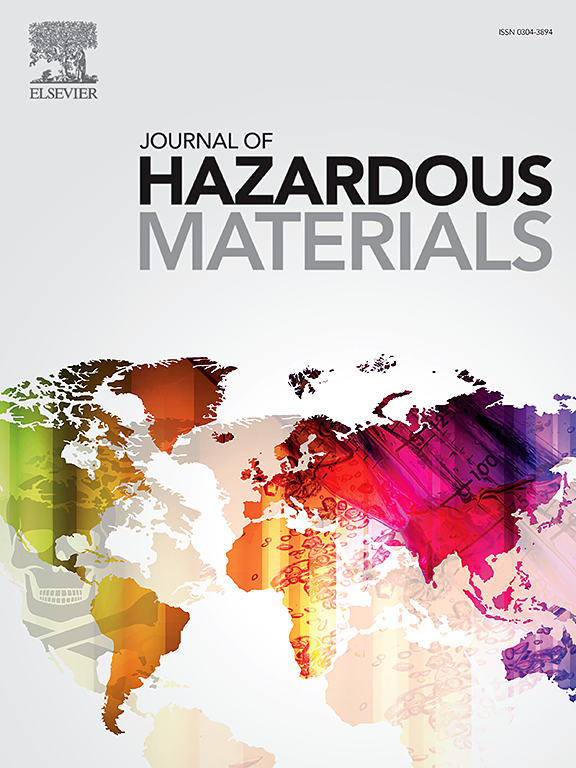紫外光老化和土壤有机质共同调控有机磷阻燃剂在PVC和PS上的吸附动力学与机理
IF 12.2
1区 环境科学与生态学
Q1 ENGINEERING, ENVIRONMENTAL
引用次数: 0
摘要
有机磷阻燃剂作为广泛使用的塑料添加剂,与微塑料广泛共存于农业土壤中,微塑料作为载体,增加了其环境风险。然而,UV老化和土壤溶解有机质(DOM)对OPFR在MPs上吸附的联合影响尚不清楚。研究了六种OPFRs在聚氯乙烯(PVC)和聚苯乙烯(PS)上的吸附动力学和机理。结果表明,OPFR的吸附与疏水性(logKow)呈正相关,以疏水相互作用和分配为主。动力学研究表明化学吸附控制吸附,遵循伪二级动力学。在紫外线老化后,PVC对极性/中极性OPFRs(磷酸三乙基、磷酸三丁酯和磷酸三(2-丁氧乙基)磷酸)的亲和力增加,这是由于亲水性微区的形成,而PS由于表面粗糙度增加和丰富的结合位点而优先吸附非极性OPFRs(磷酸三苯基和磷酸三(2-乙基己基)磷酸)。对于土壤DOM,它通过氢键竞争抑制OPFRs在PVC上的吸附,但通过π-π相互作用增强OPFRs在PS上的吸附,作为分子桥。这些发现强调了聚合物类型、紫外线老化和DOM在调节土壤中OPFRs命运中的关键作用。这将加深我们对土壤环境中多聚物复合污染所带来的环境风险的认识。本文章由计算机程序翻译,如有差异,请以英文原文为准。

UV aging and soil organic matter co-regulate the adsorption of organophosphate flame retardants on PVC and PS: Kinetics and mechanisms
As widely used plastic additives, organophosphate flame retardants (OPFRs) widely coexists with microplastics (MPs) in agricultural soil, where MPs could act as carriers, increasing their environmental risk. However, the combined effects of UV aging and soil dissolved organic matter (DOM) on OPFR adsorption to MPs remains unclear. This study investigated the adsorption kinetics and mechanisms of six OPFRs on polyvinyl chloride (PVC) and polystyrene (PS). Results showed that OPFR adsorption positively correlated with their hydrophobicity (logKow), dominated by hydrophobic interaction and partition. Kinetic studies indicated chemisorption governed adsorption, following pseudo-second-order kinetics. Upon UV aging, PVC exhibited increased affinity for polar/medium-polar OPFRs (triethyl phosphate, tributyl phosphate, and tris(2-butoxyethyl) phosphate), attributed to hydrophilic microzones formation, while PS preferentially adsorbed non-polar OPFRs (triphenyl phosphate and tris(2-ethylhexyl) phosphate) due to increased surface roughness and abundant binding sites. For soil DOM, it competitively inhibited OPFRs adsorption via hydrogen bonding on PVC but enhanced the OPFRs adsorption on PS through π-π interactions, acting as a molecular bridge. These findings highlight the critical role of polymer type, UV aging, and DOM in regulating OPFRs fate in soil. This will enhance our understanding of the environmental risks caused by the combined pollution resulting from MPs in soil environment.
求助全文
通过发布文献求助,成功后即可免费获取论文全文。
去求助
来源期刊

Journal of Hazardous Materials
工程技术-工程:环境
CiteScore
25.40
自引率
5.90%
发文量
3059
审稿时长
58 days
期刊介绍:
The Journal of Hazardous Materials serves as a global platform for promoting cutting-edge research in the field of Environmental Science and Engineering. Our publication features a wide range of articles, including full-length research papers, review articles, and perspectives, with the aim of enhancing our understanding of the dangers and risks associated with various materials concerning public health and the environment. It is important to note that the term "environmental contaminants" refers specifically to substances that pose hazardous effects through contamination, while excluding those that do not have such impacts on the environment or human health. Moreover, we emphasize the distinction between wastes and hazardous materials in order to provide further clarity on the scope of the journal. We have a keen interest in exploring specific compounds and microbial agents that have adverse effects on the environment.
 求助内容:
求助内容: 应助结果提醒方式:
应助结果提醒方式:


